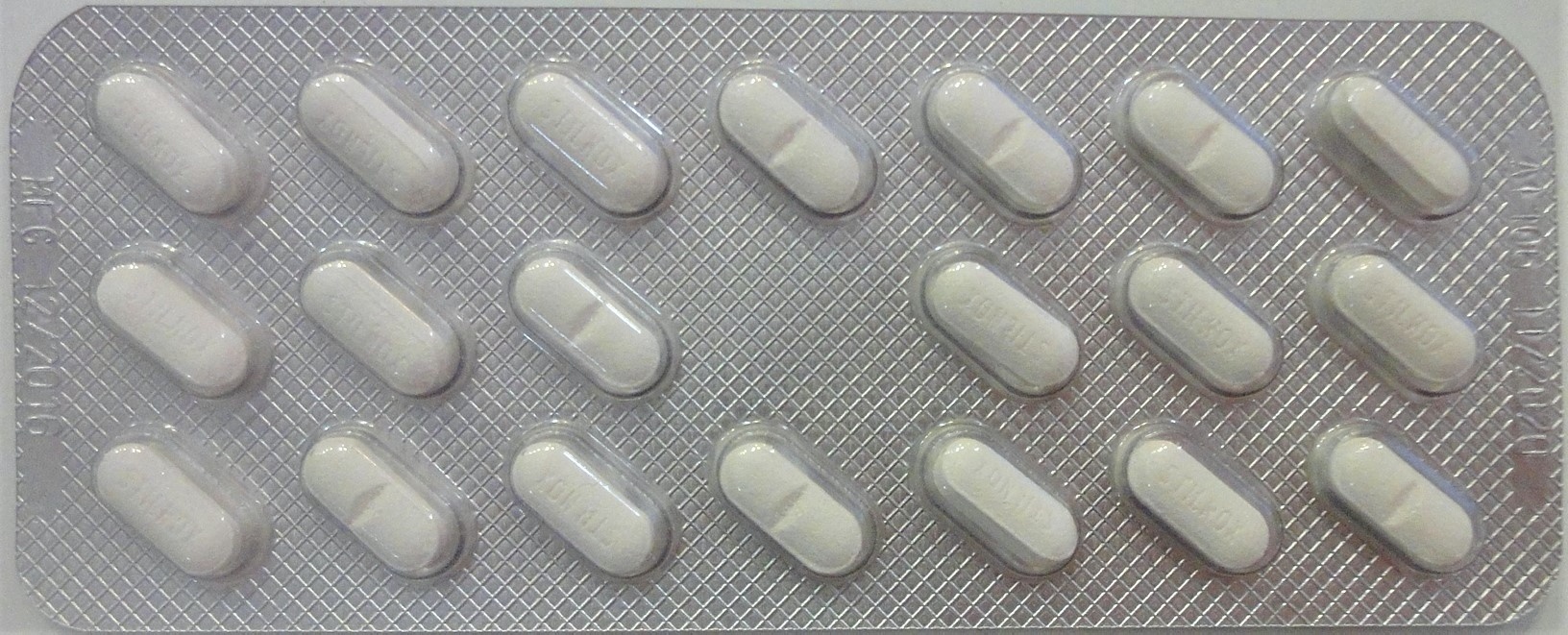STILNOX Tablet
ក្រុមហ៊ុនផលិតឱសថ:
Sanofi Winthrop Industrie, France
ក្រុមហ៊ុនចែកចាយឱសថនៅប្រទេសកម្ពុជា:
SANOFI


- សារធាតុសកម្ម
- ប្រសិទ្ធិភាពព្យាបាល និង កម្រិតប្រើប្រាស់
- ហាមប្រើ
- ផលរំខាន
- អន្តរប្រតិកម្ម
- ស្ត្រីមានផ្ទៃពោះ និង ស្ត្រីបំបៅដោះកូន
- ការប្រុងប្រយ័ត្នជាពិសេស
- សកម្មភាពឱសថ បរិយាយប័ណ្ណឱសថ
-
សារធាតុសកម្ម
Zolpidem tartrate 10mg
-
ប្រសិទ្ធិភាពព្យាបាល និង កម្រិតប្រើប្រាស់
Treatment of severe sleep disorders in the following cases:
- Occasional insomnia
- Transient insomnia.
Dosage
The treatment should always be implemented at the lowest effective dose and maximum dosage never exceeded.
The usual dose for adults is 10mg tablet daily.
The medicinal product should always be taken just before going to bed.
In elderly subjects or subjects presenting with hepatic insufficiency: dosage should be halved, 1.e. 5mg.
Dosage must never exceed 10mg/day.
Safety and effectiveness of zolpidem in paediatric patients under the age of 18 years have not been established. Therefore, STILNOX should not be prescribed in this population.
STILNOX can be prescribed either continuously or on demand, depending on the patient’s symptoms.
Treatment duration
The treatment period should be as short as possible, from a few days to 4 weeks, including the tapering period.
The patient should be advised to take the treatment as follows:
- 2-5 days for occasional insomnia. (e.g. during a trip)
- 2-3 weeks for transient insomnia (e.g. during a troubled period).
Very short treatment periods do not require any gradual treatment discontinuation.
For certain patients, it may be necessary to continue treatment for longer than 4 weeks, in which case careful and repeated reassessment of the patient’s condition is necessary.
-
ហាមប្រើ
- hypersensitivity to the active substance or any of the ingredients in the product.
- severe respiratory insufficiency
- sleep apnoea syndrome
- severe, acute or chronic hepatic omsufficiency (risk of encephalopathy)
- myasthenia gravis
- due to the lactose content, this medicinal product is contraindicated in the event of congenital galactosaemia, glucose or galactose malabsorption syndrome or lactase deficiency.
-
ផលរំខាន
These depend on dosage and the patient’s individual sensitivity.
Psychiatric and Nervous system disorders
- anterograde amnesia may occur at therapeutic dose levels with the risk increasing in proportion to dose
- Restlessness, aggression, delusion, anger, psychosis, behavior disorders, impaired consciousness, irritability, aggressiveness, agitation, hallucinations, somnambulism, depression
- physical and psychic drug dependence, even at therapeutic dose levels accompanied by withdrawal symptoms or rebound insomnia when treatment is discontinued
- feelings of ebriety, headache, ataxia, somnolence, dizziness, exacerbated insomnia
-confusion, reduced vigilance even drowsiness (especially in elderly patients), insomnia, nightmares, tension libido disorder
Skin and subcutaneous tissue disorders
- skin rash, pruritus (itching), superficial or deep (angioedema) urticaria, hyperhidrosis
General disorders
- muscle hypotonia, fatigue, unsteady fait or falls (especially in elderly subjects when dosage recommendations for zolpidem are not followed)
Eye disorders
- diplopia
Gastrointestinal disorders
- diarrhea, nausea, vomiting, abdominal pain
Hepatobiliary disorders
- elevated liver enzymes
Immune system disorders
- angioedema (e.g Quincke’s edema)
Musculoskeletal and connective tissue disorders
- muscular weakness
Respiratory, thoracic and mediastinal disorders
- respiratory depression
Infections and infestations
- upper respiratory tract infection, lower respiratory tract infection
Metabolism and nutrition disorders
- appetite disorder
-
អន្តរប្រតិកម្ម
Inadvisable combination
- Alcohol
Combinations requiring precautions for use
- Other central nervous system depressants
: Morphine derivatives (analgesics, cough suppressants and replacement treatments, other than buprenorphine); antipsychotics (neuroleptics); barbiturates; anxiolytic agents; other hypnotics; sedating antidepressants; sedating H1 antihistamines; central anti-hypertensive drugs; baclofen; thalidomide; pizotifen, antiepileptic agents, anaesthetics.
: Enhanced central depression.
- Buprenorphine
- Ketoconazole: A routine dosage adjustment of zolpidem is not considered necessary.
- Rifampicin
- Drugs that are substrates or inducers of CYP3A4.
-
ស្ត្រីមានផ្ទៃពោះ និង ស្ត្រីបំបៅដោះកូន
Pregnancy
It is preferable, as a precautionary measure, not to use zolpidem at any stage during pregnancy.
High doses of zolpidem should not be administered during the last trimester of pregnancy, as hypotonia and respiratory distress may occur in newborns at delivery. Withdrawal symptoms may occur in newborns a few days or weeks after birth.
Lactation
Breast-feeding is not recommended during treatment.
-
ការប្រុងប្រយ័ត្នជាពិសេស
- Due to the lactose content, this medicinal product is contraindicated in the event of congenital galactosaemia, glucose or galactose malabsorption syndrome or lactase deficiency.
- Pharmacological Tolerance
After repeated administration over several weeks, the sedating or hypnotic effect of benzodiazepines and related substances may gradually decrease.
- Drug Dependence
Any administration of benzodiazepines and related substances, particularly prolonged use, may induce the development of physical or psychological drug dependence.
Cases of drug abuse have been reported.
- Rebound insomnia
- Amnesia and impaired psychomotor function
- Behavior disorders (e.g., worsening of insomnia, nightmares, agitation, nervousness, delirium, hallucinations, oniric delirium, psychotic symptoms, disinhibition with impulsiveness, euphoria, irritability, anterograde amnesia, suggestibility)
This syndrome may be accompanied by disorders that could be potentially dangerous for the patient and others, such as:
- unusual patient behavior patterns
- aggressiveness to self and others, especially if the patient is prevented from doing something he/she wants to do
- automatic behavior with post-event amnesia
If these symptoms occur, treatment should be discontinued.
These symptoms are more often observed in elderly subjects.
Somnambulism and associated behaviors
Somnambulism and associated behaviors
Sleep-walking associated with other behavior such as night-time driving, cooking and eating, using the telephone or engaging in sexual intercourse, with subsequent amnesia, has been reported in patients who had taken zolpidem and were not fully awake.
Accumulation Risk
Dose adjustment may be required.
Given the metabolic route of zolpidem, this is not expected in the event of renal insufficiency.
Elderly subjects
Special precautions for use
Very great care is required in the event of history of alcoholism or drug addiction (medical products or not).
In all cases, insomnia must systematically be assessed and its causes treated before a hypnotic is prescribed.
Patients with major depression
In subjects with a major depressive episode
Gradual Discontinuation of Treatment
Children
This medicine should not be given to children aged under the age of 18 years.
Elderly subjects, Patients with hepatic insufficiency
-
សកម្មភាពឱសថ
HYPNOTICS AND SEDATIVES (N; Central Nervous System)
Zolpidem is a hypnotic imidazopyridine related to benzodiazepines with a pharmacodynamics activity qualitatively similar to that of other compounds in the same class.
- muscle relaxant,
- anxiolytic,
- sedating,
- hypnotic,
- anticonvulsant,
- amnesic.
Experimental studies have evidenced sedating effects at doses lower than those required to obtain anticonvulsant, muscle relaxant and anxiolytic effects.
These effects are related to specific agonist action at a central receptor belonging to the GABA-omega (BZ1 and BZ2) ‘macromolecular receptor complex”, modulating the opening of the chloride ion channel.
Zolpidem binds selectively onto the omega 1 subtype (or BZ1). In man, zolpidem shortens time to falling asleep, reduces the number of night awakenings, increases total sleep duration and improves quality of sleep, These effects are associated with a characteristic electroencephalographic profile, different to that induced by benzodiazepines. Night-sleep recording studies have demonstrated that zolpidem prolongs stage Ⅱsleep and deep sleep (Ⅲ and Ⅳ). At recommended doses, zolpidem does not affect total duration of paradoxical sleep (R.E.M.).
*ព័ត៌មានឱសថត្រូវបានរៀបរៀងដោយ អ៊ីម៉ាតុគឹ មេឌីក (ខេមបូឌា) ដោយផ្អែកលើប្រភពព័ត៌មានខាងក្រោម។ សម្រាប់ព័ត៌មានលម្អិត សូមស្វែងរកនៅក្នុងក្រដាសព័ត៌មាននៃឱសថនីមួយៗ ឬ សាកសួរទៅកាន់ក្រុមហ៊ុនឱសថឬតំណាងចែកចាយនៃឱសថនីមួយៗ។
ប្រភពព័ត៌មាន៖
- ក្រដាសព័ត៌មាននៃឱសថសម្រាប់អ្នកជំនាញវេជ្ជសាស្ត្រដែលប្រើប្រាស់នៅប្រទេសជប៉ុន (Pharmaceutical and Medical Devices Agency, Pmda): https://www.pmda.go.jp
- ព័ត៌មានសង្ខេបនៃឱសថសម្រាប់អ្នកជំងឺដែលប្រើប្រាស់នៅប្រទេសជប៉ុន: http://www.rad-ar.or.jp
